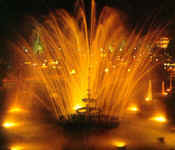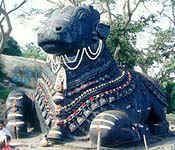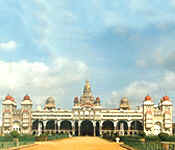Apr 20, 2024
Apr 20, 2024
 Mysore a name that has embedded so deeply in our Indian consciousness. Every lady in India aspires to wear a Mysoree silk sari, Mysore pak is a favorite sweet meat for many Indians, Mysore Sandal Soap is something most of us used to take bath with as kids. Mysore the city of dazzling palaces, glittering silks, sandalwood handicrafts. A city with a glorious history, a vibrant present and a promising tomorrow. Its a city where one can keep one's soul intact, and people have not yet rushed headlong into consumerism and money mindedness. A truly lovely city it has not yet turned into the vast overcrowded slums unlike other Indian cities. The city of rich culture, the home of the Caryatid music, Mysore paintings yet this city is a thriving industrial, commercial center and also the next techno polis after Ban galore.
Mysore a name that has embedded so deeply in our Indian consciousness. Every lady in India aspires to wear a Mysoree silk sari, Mysore pak is a favorite sweet meat for many Indians, Mysore Sandal Soap is something most of us used to take bath with as kids. Mysore the city of dazzling palaces, glittering silks, sandalwood handicrafts. A city with a glorious history, a vibrant present and a promising tomorrow. Its a city where one can keep one's soul intact, and people have not yet rushed headlong into consumerism and money mindedness. A truly lovely city it has not yet turned into the vast overcrowded slums unlike other Indian cities. The city of rich culture, the home of the Caryatid music, Mysore paintings yet this city is a thriving industrial, commercial center and also the next techno polis after Ban galore.
 Legend has it that this city was named after the Buffalo demon Mahishasura whom Goddess Durga splayed here, no wonder that Dussehra is the main festival here. Every city in India is associated with a dynasty which has played a major role in the development of the city, Tanjore and the Chelas, Hydria and the ASAP Janis, Madera and the Pandas and when one speaks of Mysore, the Wodeyars are the ruling family here, they are one of the few royal families that still play a major role like the Scindias in Gwalior. The old province of Mysore comprised the areas of Mysore, Talakad, Kodagu and Srirangapatnam. The Wodeyar dynasty which was founded by Yaduraya in 1399 AD has dominated most of Mysore history. Chikkadevara Wodeyar was the man who expanded the Mysore empire while Kantareeva Narasimha Raja Wodeyar recaptured Mysore from the Dalavayis. The interim period saw the rise to power of two of India's most famous personalities-Hyder Ali and Tipu Sultan. Tipu Sultan was the first to build an army on scientific lines and took on the might of the British. Known as the Tiger of Mysore, his acts of courage, bravery are renowned. This brave heart died at Srirangapatna fighting till the last.
Legend has it that this city was named after the Buffalo demon Mahishasura whom Goddess Durga splayed here, no wonder that Dussehra is the main festival here. Every city in India is associated with a dynasty which has played a major role in the development of the city, Tanjore and the Chelas, Hydria and the ASAP Janis, Madera and the Pandas and when one speaks of Mysore, the Wodeyars are the ruling family here, they are one of the few royal families that still play a major role like the Scindias in Gwalior. The old province of Mysore comprised the areas of Mysore, Talakad, Kodagu and Srirangapatnam. The Wodeyar dynasty which was founded by Yaduraya in 1399 AD has dominated most of Mysore history. Chikkadevara Wodeyar was the man who expanded the Mysore empire while Kantareeva Narasimha Raja Wodeyar recaptured Mysore from the Dalavayis. The interim period saw the rise to power of two of India's most famous personalities-Hyder Ali and Tipu Sultan. Tipu Sultan was the first to build an army on scientific lines and took on the might of the British. Known as the Tiger of Mysore, his acts of courage, bravery are renowned. This brave heart died at Srirangapatna fighting till the last.
 The modern phase of Mysore began from 1800 with the ascent to the throne of Krishnaraja Wodeyar III. Governor William Bentick took over Mysore in 1831 and in 1881 restored it back to Chamaraja Wodeyar. But Mysore began its phase of development and modernization under the rule of Krishnaraja Wodeyar IV from 1895-1940 often referred to as the Golden Age of Mysore. He was assisted by his two Dewans-Mirza Ismail and the towering genius, builder, engineer Sri M.Viswesarayya. The Mysore Palace, Jaganmohan Palace, Lalita Mahal palace all were built during this period. The world famous Brindavan Gardens and the Krishnaraja Sagar dam were built in this time too. With the advent of Independence in 1947,Mysore passed under the Government and the Wodeyar dynasty came to an end.
The modern phase of Mysore began from 1800 with the ascent to the throne of Krishnaraja Wodeyar III. Governor William Bentick took over Mysore in 1831 and in 1881 restored it back to Chamaraja Wodeyar. But Mysore began its phase of development and modernization under the rule of Krishnaraja Wodeyar IV from 1895-1940 often referred to as the Golden Age of Mysore. He was assisted by his two Dewans-Mirza Ismail and the towering genius, builder, engineer Sri M.Viswesarayya. The Mysore Palace, Jaganmohan Palace, Lalita Mahal palace all were built during this period. The world famous Brindavan Gardens and the Krishnaraja Sagar dam were built in this time too. With the advent of Independence in 1947,Mysore passed under the Government and the Wodeyar dynasty came to an end.
While Mysore does have a number of palaces, forts, museums the crowning glory is undoubtedly the Mysore Maharaja Palace. The original wooden palace was destroyed by a fire in 1897 and the new one was rebuilt by Henry Irwin in 1911.The exterior of the palace has Indo saracenic features with a series of domes and arches. The interior of the palace is richly decorated especially the Grand Durbar Hall. Filled with ornate ceilings, intricately carved doors, frescos from the epics give a royal splendour.To the south we have the Kalyana Mantapam, which has an octagonal roof covered by stainless glasses. Tall iron pillars wrought at Glasgow adorn the central hall. The glazed tiles on the floor are imported from England while the chandeliers are of Czechoslovakian make. The royal throne believed to be captured from the Vijayanagar empire is displayed during the Dussehra festival. The second floor has the Diwan-i-Am durbar hall which contain some wonderful paintings. To the south we have the Amba Vilas, the Diwan-i-Khas which has some wonderful inlay work, frescoes and tastefully decorated pillars, ceilings. During Sundays, public holidays the entire palace is decorated with lights making it a treat to watch, and its also illuminated during entire Dussehra.
If the visit to the Mysore palace has exhausted you or you would love to have a more romantic getaway, the Brindavan Gardens is the right place for you. These world famous gardens would be familiar to many viewers of Bollywood, Tollywood films where the hero and heroine would croon sweet nothings. Built in 1932 during the reign of Krishnaraja Wodeyar IV on the terraces of the Krishnaraja Sagar dam its a meticoulosy planned garden. While the dam was built by Vishweswarayya the gardens were designed by Sir Mirza Ismail. The massive dam was conceived as a multi purpose project by Shri Viswesarayya,for satisfying the water needs of the agricultural lands in Mandya, Mysore and ensuring power supply to Sivasamudram project. The gardens contain a number of fountains in all shapes and sizes and in the evenings they are tastefully illuminated giving the entire gardens a fairy tale look.
The Chamundi hills which dominate the landscape of Mysore contains the 12th century temple of Chamundeswari Devi, the patron god of the Wodeyar Dynasty. The 16 ft high Nandi statue carved out of a single rock is one of the most magnificent sculptures and the second of its kind in India (the other one in Lepakshi, AP). The Chamarajendra Art Gallery contains the famous Mysore paintings and invaluable paintings of Raja Ravi Varma. There is a vast collection of art objects like the drama clock from England, Japanese carvings, Roman carvings etc.The Mysore Zoo established in 1892 is regarded as one of the finest zoos in India. The zoo has a collection of white tigers and there are 2000 animals, 85 species of plants in the campus. The St. Philomena's Church is one of the oldest churches in India. Built in 1840, this is patterned on the lines of the Cologne Church in Germany. The cathedral rise to a height of 165 ft and has beautiful glass stained interiors which depict the story of Christ.
And any visit to Mysore would be incomplete without a visit to Srirangapatna, the summer capital of Tippu Sultan. Now a small dusty town, its name is derived from the massive Ranganatha Temple dedicated to Lord Ranganatha and one of the 3 temples to contain Vishnu in a sleeping pose (Srirangam in Trichy and Anantapadmanabhaswamy temple in Trivandrum are the others). The most famous sight is Dariya Bagh the summer palace of Tippu Sultan which he built in 1784. He named it as Dariya Daulat Bagh which means wealth of the sea. The walls of the palace contains paintings of the battles fought against the British and the various belongings of Tipu are also exhibited, including his famous sword. The Gumbaz at the other end of the town contains the tomb of Hyder Ali and Tipu Sultan.
Apart from that Mysore is also the starting point to many other famous tourist spots like the wildlife sanctuaries of Bandipur, Nagarhole and Ranganathittu, the hill stations of Coorg and Ooty, historic places like Halebid, Shravanabelagola. Mysore is also a major center of fine arts and culture in India. The famous Mysore paintings originate here. The prestigious Fine Arts college imparts teaching in Music, drama and dance. The sandalwood crafts made her are world famous while the silk saris are the most sought after by Indian ladies. The rich culture of Mysore can be seen during the Dussehra festivities when leading musicians, singers, dancers exhibit their talents here. Mysore is also one of India's leading educational centers in India. The Central Food Technological Research Institution, DRDL, are prominent among them. The Mysore University is one of the oldest ones in India. The National Institute of Engineering is one of the most prominent engineering colleges in India. It also has the famous Mysore Medical College and a number of professional institutions.
With such a plethora of riches its no wonder that Mysore has produced some of the greatest persons in India. M. Visweswarayya the towering genius, administrator and builder. Field Marsha Cariappa the first Commander in Chief of Free India hailed from Coorg. Kuvempu the towering literary genius and Jnanpeeth award winner. R.K.Narayan the famous Indian writer, Dr. Raja Rammana, cricketers like Javagal Srinath and last but not the least M.R.Narayanamurthy, the founder of Infosys who set new standards in management and pioneered India's entry into the information age. With a pleasant climate, peaceful atmosphere, leisurely pace of life, one hopes that Mysore shall always retain its charm.
26-Aug-2001
More by : Ratnakar Sadasyula